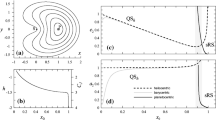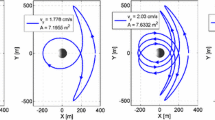Abstract
We are interested in stable periodic orbits for spacecraft in the gravitational field of minor celestial bodies. The stable periodic orbits around minor celestial bodies are useful not only for the mission design of the deep space exploration, but also for studying the long-time stability of small satellites in the large-size-ratio binary asteroids. The irregular shapes and gravitational fields of the minor celestial bodies are modeled by the polyhedral model. Using the topological classifications of periodic orbits and the grid search method, the stable periodic orbits can be calculated and the topological cases can be determined. Furthermore, we find five different types of stable periodic orbits around minor celestial bodies: (1) stable periodic orbits generated from the stable equilibrium points outside the minor celestial body; (2) stable periodic orbits continued from the unstable periodic orbits around the unstable equilibrium points; (3) retrograde and nearly circular periodic orbits with zero-inclination around minor celestial bodies; (4) resonance periodic orbits; (5) near-surface inclined periodic orbits. We take asteroids 243 Ida, 433 Eros, 6489 Golevka, 101955 Bennu, and the comet 1P/Halley for examples.
Similar content being viewed by others
Change history
11 February 2022
A Correction to this paper has been published: https://doi.org/10.1007/s42064-022-0136-2
References
Scheeres, D. J., Fahnestock, E. G., Ostro, S. J., Margot, J.-L., Benner, L. A. M., Broschart, S. B., Bellerose, J., Giorgini, J. D., Nolan, M. C., Magri, C., Pravec, P., Scheirich, P., Rose, R., Jurgens, R. F., De Jong, E. M., Suzuki, S. Dynamical configuration of binary near-Earth asteroid (66391) 1999 KW4. Science, 2006, 314(5803): 1280–1283.
Taylor, P. A., Margot, J. L. Binary asteroid systems: Tidal end states and estimates of material properties. Icarus, 2011, 212(2): 661–676.
Chanut, T. G. G., Winter, O. C., Tsuchida, M. 3D stability orbits close to 433 Eros using an effective polyhedral model method. Monthly Notices of the Royal Astronomical Society, 2014, 438(3): 2672–2682.
Chanut, T. G. G., Winter, O. C., Amarante, A., Araujo, N. C. S. 3D plausible orbital stability close to asteroid (216) Kleopatra. Monthly Notices of the Royal Astronomical Society, 2015, 452(2): 1316–1327.
Chanut, T. G. G., Aljbaae, S., Carruba, V. Mascon gravitation model using a shaped polyhedral source. Monthly Notices of the Royal Astronomical Society, 2015, 450(4): 3742–3749.
Jiang, Y., Baoyin, H., Li, J., Li, H. Orbits and manifolds near the equilibrium points around a rotating asteroid. Astrophysics and Space Science, 2014, 349(1): 83–106.
Jiang, Y., Yu, Y., Baoyin, H. Topological classifications and bifurcations of periodic orbits in the potential field of highly irregular-shaped celestial bodies. Nonlinear Dynamics, 2015, 81(1–2): 119–140.
Jiang, Y., Baoyin, H., Li, H. Collision and annihilation of relative equilibrium points around asteroids with a changing parameter. Monthly Notices of the Royal Astronomical Society, 2015, 452(4): 3924–3931.
Jiang, Y., Baoyin, H., Wang, X., Yu, Y., Li, H., Peng, C., Zhang, Z. Order and chaos near equilibrium points in the potential of rotating highly irregular-shaped celestial bodies. Nonlinear Dynamics, 2016, 83(1–2): 231–252.
Jiang, Y., Zhang, Y., Baoyin, H. Surface motion relative to the irregular celestial bodies. Planetary and Space Science, 2016, 127: 33–43.
Scheeres, D. J., Williams, B. G., Miller, J. K. Evaluation of the dynamic environment of an asteroid: Applications to 433 Eros. Journal of Guidance, Control, and Dynamics, 2000, 23(3): 466–475.
Elipe, A., Lara, M. A simple model for the chaotic motion around (433) Eros. The Journal of the Astronautical Sciences, 2003, 51(4): 391–404.
Palacan, J. F., Yanguas, P., Guterrez-Romero, S. Approximating the invariant sets of a finite straight segment near its collinear equilibria. SIAM Journal of Applied Dynamical Systems, 2006, 5(1): 12–29.
Vasilkova, O. Three-dimensional periodic motion in the vicinity of the equilibrium points of an asteroid. Astronomy & Astrophysics, 2005, 430(2): 713–723.
Yu, Y., Baoyin, H. Generating families of 3D periodic orbits about asteroids. Monthly Notices of the Royal Astronomical Society, 2012, 427(1): 872–881.
Jiang, Y., Baoyin, H., Li, H. Periodic motion near the surface of asteroids. Astrophysics and Space Science, 2015, 360(2): 63.
Jiang, Y., Baoyin, H. Periodic orbit families in the gravitational field of irregular-shaped bodies. The Astronomical Journal, 2016, 152(5): 137.
Ni, Y., Jiang, Y., Baoyin, H. Multiple bifurcations in the periodic orbit around Eros. Astrophysics and Space Science, 2016, 361(5): 170.
Hamilton, D. P., Burns, J. A. Orbital stability zones about asteroids: II.The destabilizing effects of eccentric orbits and of Solar radiation. Icarus, 1992, 96(1): 43–64.
Wang, Y., Xu, S., Zhu, M. Stability of relative equilibria of the full spacecraft dynamics around an asteroid with orbit–attitude coupling. Advances in Space Research, 2014, 53(7): 1092–1107.
Antoniadou, K. I., Voyatzis, G. Resonant periodic orbits in the exoplanetary systems. Astrophysics and Space Science, 2014, 349(2): 657–676.
Scheeres, D. J., Ostro, S. J., Hudson, R. S., Werner, R. A. Orbits close to asteroid 4769 Castalia. Icarus, 1996, 121(1): 67–87.
Scheeres, D. J., Ostro, S. J., Hudson, R. S., De Jong, E. M., Suzuki, S. Dynamics of orbits close to asteroid 4179 Toutatis. Icarus, 1998, 132(1): 53–79.
Jiang, Y. Equilibrium points and periodic orbits in the vicinity of asteroids with an application to 216 Kleopatra. Earth, Moon and Planets, 2015, 115(1–4): 31–44.
Werner, R. A. The gravitational potential of a homogeneous polyhedron or don’t cut corners. Celestial Mechanics and Dynamical Astronomy, 1994, 59(3): 253–278.
Werner, R. A., Scheeres, D. J. Exterior gravitation of a polyhedron derived and compared with harmonic and mascon gravitation representations of asteroid 4769 Castalia. Celestial Mechanics and Dynamical Astronomy, 1997, 65(3): 313–344.
Wang, X., Jiang, Y., Gong, S. Analysis of the potential field and equilibrium points of irregular-shaped minor celestial bodies. Astrophysics and Space Science, 2014, 353(1): 105–121.
Richardson, D. C., Michel, P., Walsh, K. J., Flynn, K. W. Numerical simulations of asteroids modelled as gravitational aggregates with cohesion. Planetary and Space Science, 2009, 57(2): 183–192.
Hirabayashi, M., Scheeres, D. J. Analysis of asteroid (216) Kleopatra using dynamical and structural constraints. The Astrophysical Journal, 2014, 780(2): 160.
Gabriel, T. S. J., Scheeres, D. J. Energy dissipation end states of the sphere restricted planar three-body problem with collisional interaction. Monthly Notices of the Royal Astronomical Society, 2016, 463(1): 794–801.
Gaskell, R. W. Gaskell Eros Shape Model V1.0. NEARA-MSI-5-EROSSHAPE-V1.0. NASA Planetary Data System. 2008.
Petit, A., Souchay, J., Lhotka, C. High precision model of precession and nutation of the asteroids (1) Ceres, (4) Vesta, (433) Eros, (2867) Steins, and (25143) Itokawa. Astronomy & Astrophysics, 2014, 565: A79.
Miller, J. K., Konopliv, A. S., Antreasian, P. G., Bordi, J. J., Chesley, S., Helfrich, C. E., Owen, W. M., Wang, T. C., Williams, B. G., Yeomans, D. K., Scheeres, D. J. Determination of shape, gravity, and rotational state of asteroid 433 Eros. Icarus, 2002, 155(1): 3–17.
Scheeres, D. J. Orbital mechanics about small bodies. Acta Astronautica, 2012, 72: 1–14.
Tresaco, E., Elipe, A., Riaguas, A. Computation of families of periodic orbits and bifurcations around a massive annulus. Astrophysics and Space Science, 2012, 338(1): 23–33.
Russell, R. P. Survey of spacecraft trajectory design in strongly perturbed environments. Journal of Guidance, Control, and Dynamics, 2012, 35(3): 705–720.
Acknowledgements
This research was supported by the State Key Laboratory of Astronautic Dynamics Foundation (No. 2016ADL0202).
Author information
Authors and Affiliations
Corresponding author
Additional information
Yu Jiang received his bachelor degree from Peking University, and master degree as well as Ph.D. degree from Tsinghua University. He is now a researcher in State Key Laboratory of Astronautic Dynamics and Tsinghua University. His research interests are in the dynamics and control around multiple asteroid systems, surface motion and soft-landing on minor bodies, space debris, as well as cometary dust dynamics.
Jürgen Arno Schmidt received his diploma degree in theoretical physics from the University of Saarbrcken, Germany, and his Ph.D. degree in theoretical physics from the University of Potsdam, Germany. He is now professor in the Astronomy Research Unit of the University of Oulu, Finland. His research interests in the field of celestial mechanics focus on the dynamics of circumplanetary dust and dense planetary rings. He is co-investigator in the science teams of the Cassini Cosmic Dust Analyzer, the Surface Dust Mass Analyzer of the Europa Clipper Mission, and the JANUS camera onboard the Jupiter Icy Moons Explorer.
Hengnian Li received his bachelor degree in mathematical computation from Lanzhou University, and master degree in computer science from National University of Defence Technology as well as Ph.D. degree in system science and engineering from Xi’an Jiaotong University. He is now the director as well as a researcher in State Key Laboratory of Astronautic Dynamics, China. His research interests cover many fields in spacecraft dynamics and control, including to orbital perturbation models, orbital tracking and precision determination, artificial intelligent machine learning, etc.
Xiaodong Liu received his B.S. degree in engineering mechanics from Shandong University in 2008, and Ph.D. degree in aeronautical and astronautical science and technology from Tsinghua University in 2013. He received the grand prize for graduate students at Tsinghua University, and national excellent doctor thesis in the field of aeronautical and astronautical science and technology. Currently he is a postdoctoral researcher in the Astronomy Research Unit at University of Oulu, Finland. His research interest focuses on circumplanetary and interplanetary dust dynamics, tenuous planetary rings, estimate of dust hazard to spacecraft, and orbital dynamics around non-spherical bodies.
Yue Yang received her bachelor degree from Sichuan University. She is now a graduate student in Xi’an Jiaotong University, majoring in software engineering. Her research interests are in data mining and performance abnormality diagnosis.
Rights and permissions
About this article
Cite this article
Jiang, Y., Schmidt, J.A., Li, H. et al. Stable periodic orbits for spacecraft around minor celestial bodies. Astrodyn 2, 69–86 (2018). https://doi.org/10.1007/s42064-017-0014-5
Received:
Accepted:
Published:
Issue Date:
DOI: https://doi.org/10.1007/s42064-017-0014-5




